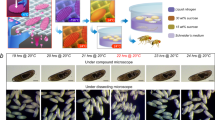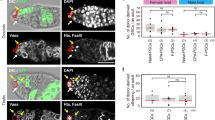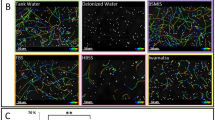Abstract
THERE is an urgent need to preserve the ever-increasing number (>30,000) of different genetic strains of D. melanogaster that are maintained in national and international stock centres and in the laboratories of individual investigators. In all cases, the stocks are maintained as adult populations and require transfer to fresh medium every two to four weeks. This is not only costly in terms of materials, labour and space, but unique strains are vulnerable to accidental loss, contamination, and changes in genotype that can occur during continuous culture through mutation, genetic drift or selection. Although Cryopreservation of Drosophila germ-plasm would be an enormous advantage, many attempts using conventional procedures have been unsuccessful. D. melanogaster embryos are refractory to conventional cryopreservation procedures because of the contravening conditions required to minimize mortality resulting from both intracellular ice formation and chilling injury at subzero temperatures. To overcome these obstacles, we have developed a vitrification procedure that precludes intracellular ice formation so that the embryos can be cooled and warmed at ultra-rapid rates to minimize chilling injury, and have recovered viable embryos following storage in liquid nitrogen. In a series of 53 experiments, a total of 3,711 larvae emerged from 17,280 eggs that were cooled in liquid nitrogen (18.4 ±8.8%). Further, using a subset from this population, approximately 3% of the surviving larvae (24/800) developed into adults. These adutts were fertile and produced an F1 generation.
This is a preview of subscription content, access via your institution
Access options
Subscribe to this journal
Receive 51 print issues and online access
$199.00 per year
only $3.90 per issue
Buy this article
- Purchase on Springer Link
- Instant access to full article PDF
Prices may be subject to local taxes which are calculated during checkout
Similar content being viewed by others
References
Lynch, D. V. et al. Cryobiology 26, 445–452 (1989).
Mazur, P., Schneider, U., Jacobson, K. B. & Mahowald, A. P. Cryobiology 25, 544 (1988).
Myers, S. P., Lynch, D. V., Knipple, D. C., Leibo, S. P. & Steponkus, P. L. Cryobiology 25, 544–545 (1988).
Rall, W. F., Reid, D. S. & Polge, C. Cryobiology 21, 106–121 (1984).
Myers, S. P., Pitt, R. E., Lynch, D. V. & Steponkus, P. L. Cryobiology 26, 472–484 (1989).
Lin, T.-T., Pitt, R. E. & Steponkus, P. L. Cryobiology, 26, 453–471 (1989).
Leibo, S. P., Myers, S. P. & Steponkus, P. L. Cryobiology 25, 545–546 (1988).
Fahy, G. M., MacFarlane, D. R., Angell, C. A., & Meryman, H. T. Cryobiology 21, 407–426 (1984).
Rall, W. F. & Fahy, G. M. Nature 313, 573–575 (1985).
Limbourg, B. & Zalokar, M. Devl Biol. 35, 382–387 (1973).
Crowley, C. W., Timson, W. J. & Sawdye, J. A. Biodynamica 8, 317–330 (1961).
MacFarlane, D. R. Cryobiology 24, 181–195 (1987).
MacFarlane, D. R. Cryobiology 23, 230–244 (1986).
Morris, G. J. in The Effects of Low Temperatures on Biological Systems (eds Grout, B. W. W. & Morris, G. J.) 120–146 (Arnold, London, 1987).
Author information
Authors and Affiliations
Rights and permissions
About this article
Cite this article
Steponkus, P., Myers, S., Lynch, D. et al. Cryopreservation of Drosophila melanogaster embryos. Nature 345, 170–172 (1990). https://doi.org/10.1038/345170a0
Received:
Accepted:
Issue Date:
DOI: https://doi.org/10.1038/345170a0
This article is cited by
-
Advanced cryopreservation engineering strategies: the critical step to utilize stem cell products
Cell Regeneration (2023)
-
Cryopreservation of Anopheles stephensi embryos
Scientific Reports (2022)
-
Cryopreservation method for Drosophila melanogaster embryos
Nature Communications (2021)
-
Offspring production from cryopreserved primordial germ cells in Drosophila
Communications Biology (2021)
-
Preservation of connexin 43 and transzonal projections in isolated bovine pre-antral follicles before and following vitrification
Journal of Assisted Reproduction and Genetics (2021)
Comments
By submitting a comment you agree to abide by our Terms and Community Guidelines. If you find something abusive or that does not comply with our terms or guidelines please flag it as inappropriate.



